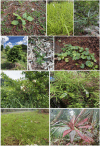Ethnobotanical study of traditional medicinal plants used by the Miao people in Hainan, China
- PMID: 40524191
- PMCID: PMC12168294
- DOI: 10.1186/s13002-025-00795-z
Ethnobotanical study of traditional medicinal plants used by the Miao people in Hainan, China
Abstract
Background: The Miao people in Hainan possesses a profound historical heritage and unique ethnic culture. Through centuries of confronting survival challenges in tropical rainforest mountains, they have accumulated abundant knowledge of disease prevention and treatment. However, the traditional medicinal knowledge of the Hainan Miao people has been scarcely documented to date. This ethnobotanical study aims to: (1) record Miao people's traditional medicinal knowledge; (2) analyze medicinal properties and threats; (3) put forward suggestions for promoting the development of traditional medical knowledge of the Miao people.
Methods: From 2020 to 2022, 35 key informants (Miao healers, local herbalists, and plants gatherers, age range is 30-99 years) were interviewed in 11 regions of Hainan by means of participatory observation, semi-structured interview, key informant interview, and group discussion. The quantitative analysis employed the use value (UV), informant consensus factor (ICF), relative frequency of citation (RFC), and similarity index (Cj). The International Classification of Primary Care-2nd (ICPC-2) was used to classify the diseases treated by medicinal plants.
Results: A total of 348 medicinal plant species belonging to 114 families were recorded. These were primarily herbaceous plants (37.71%), with leaves (48.85%) most used, and decoction (39.94%) most frequently employed. Among them, 37 medicinal plants documented in this study were recorded for their medicinal value for the first time, enriching the database of medicinal plant resources. These plants are used to treat 140 different diseases, which can be categorized into 14 disease categories, primarily focusing on the treatment of musculoskeletal (L), respiratory (R), and digestive (D) disease with medicinal plants. The informant consensus factor (ICF) values for these categories are 0.55, 0.51, and 0.5, respectively. In addition, the use value (UV) values of Stephania succifera and Sarcandra glabra are relatively high. Plantago asiatica, Imperata cylindrica, Homonoia riparia, and Aquilaria sinensis had high relative frequency of citation (RFC) values, between 0.05 and 0.16. Furthermore, the Hainan Miao and the Li ethnic groups exhibit a high degree of similarity in their use of medicinal plants due to their similar living environments and the inheritance of traditional medicinal knowledge. In contrast, compared to the Guizhou Miao ethnic group, significant differences arise due to the differing geographical environments and living habits.
Conclusion: This demonstrates that through oral transmission and personal instruction, knowledge of medicinal plants diversity has been passed down from generation to generation, ensuring its continuity and preserving a unique traditional culture for treating various diseases. However, the aging of knowledge holders poses a threat to the loss of traditional knowledge, making it imperative to take measures to preserve the continuity of this knowledge. This survey provides valuable data and insights for the sustainable utilization and conservation of Miao medicinal plant resources, as well as the transmission of traditional medical knowledge.
Keywords: Ethnobotany; Hainan; Indigenous knowledge; Medicinal plants; Miao people.
© 2025. The Author(s).
Conflict of interest statement
Declarations. Ethics approval and consent to participate: Permissions were provided by all participants in this study, including the Miao healers and local people. Consent was obtained from the local communities prior to the field investigations. The authors have all copyrights. Consent for publication: Not applicable. Competing interests: The authors declare no competing interests.
Figures








Similar articles
-
Traditional ethnobotanical knowledge of important local plants in Sudhnoti, Azad Kashmir, Pakistan.Sci Rep. 2024 Sep 27;14(1):22165. doi: 10.1038/s41598-024-73431-7. Sci Rep. 2024. PMID: 39333361 Free PMC article.
-
Medicinal plants traded in Hakka communities of southeastern Guangxi, China.J Ethnobiol Ethnomed. 2025 Jul 11;21(1):47. doi: 10.1186/s13002-025-00796-y. J Ethnobiol Ethnomed. 2025. PMID: 40646539 Free PMC article.
-
Traditional ecological knowledge and practices in Zimbabwe: medicinal ethnobotany and ethnozoology among communities in Chipinge district.J Ethnobiol Ethnomed. 2025 Aug 14;21(1):55. doi: 10.1186/s13002-025-00809-w. J Ethnobiol Ethnomed. 2025. PMID: 40813672 Free PMC article.
-
Management of urinary stones by experts in stone disease (ESD 2025).Arch Ital Urol Androl. 2025 Jun 30;97(2):14085. doi: 10.4081/aiua.2025.14085. Epub 2025 Jun 30. Arch Ital Urol Androl. 2025. PMID: 40583613 Review.
-
Home treatment for mental health problems: a systematic review.Health Technol Assess. 2001;5(15):1-139. doi: 10.3310/hta5150. Health Technol Assess. 2001. PMID: 11532236
References
-
- Sen T, Samanta SK. Medicinal plants, human health and biodiversity: a broad review. Adv Biochem Eng Biotechnol. 2015;147:59–110. 10.1007/10_2014_273. - PubMed
-
- Manandhar N. Native phytotherapy among the Raute tribes of Dadeldhura district. Nepal J Ethnopharmacol. 1998;60:199–206. 10.1016/S0378-8741(97)00150-5. - PubMed
MeSH terms
Supplementary concepts
Grants and funding
LinkOut - more resources
Full Text Sources

